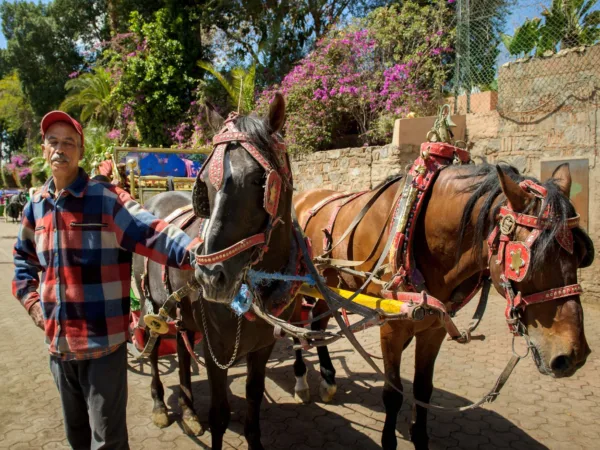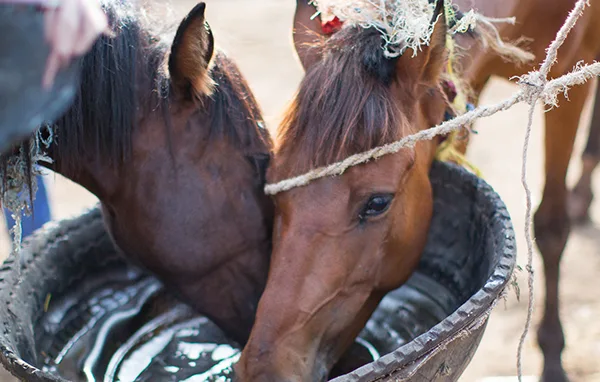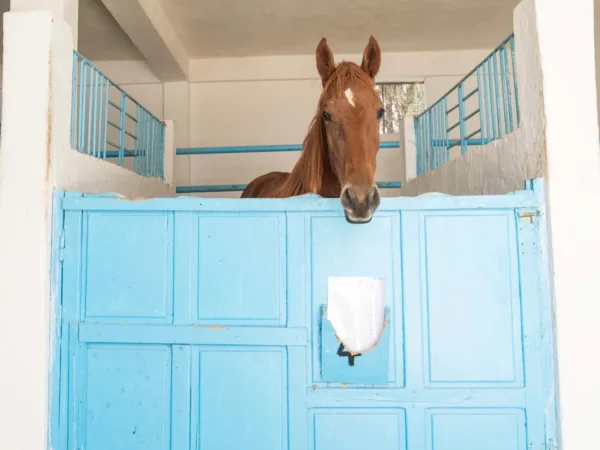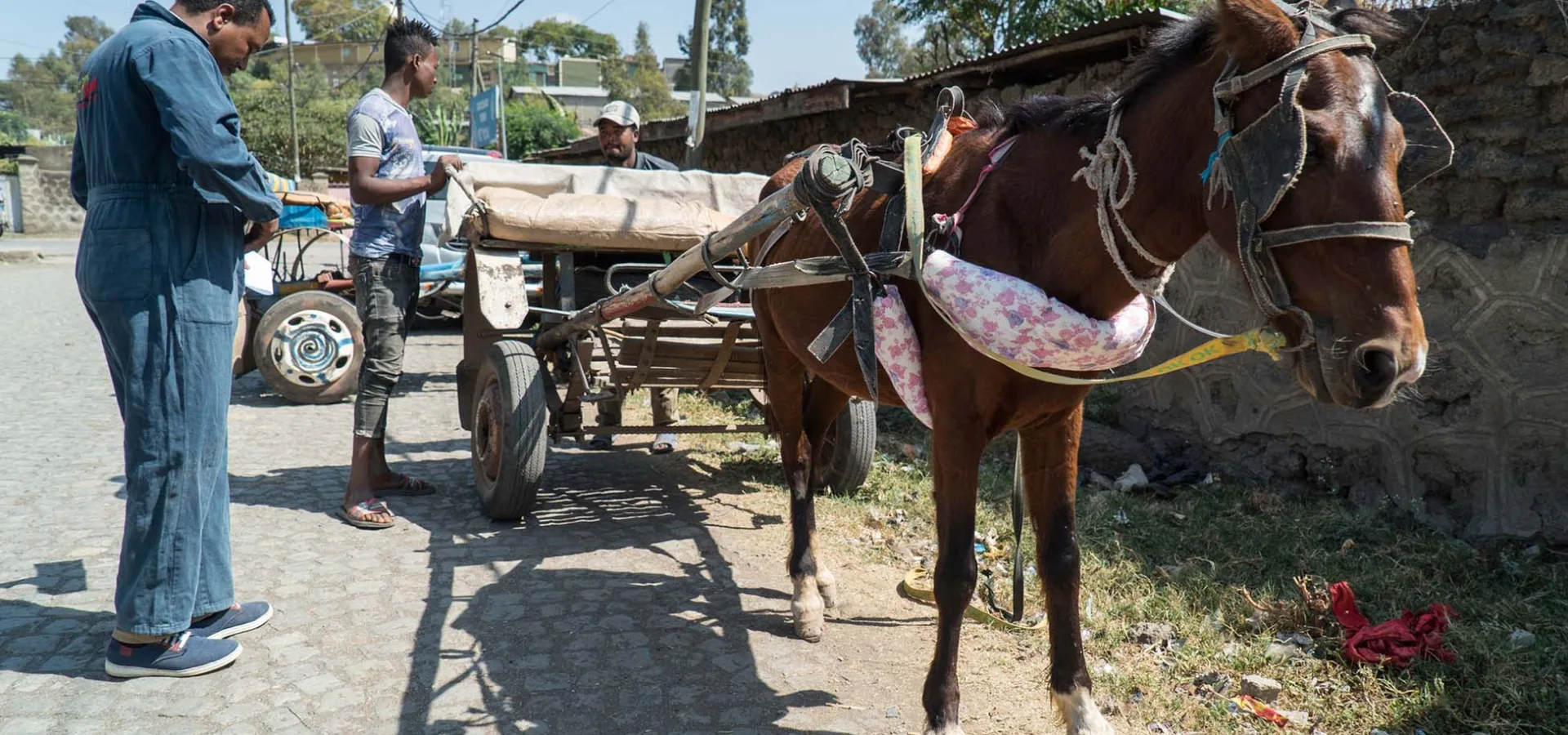
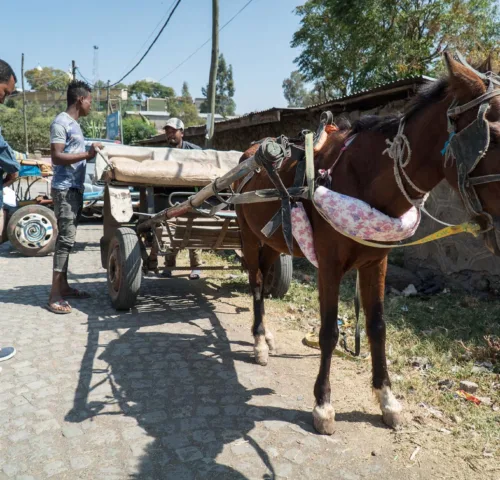
A guide to horse harness parts
All too often, SPANA vets treat injuries and infections caused by poorly fitting harnesses that have rubbed and injured the animal. Read more about harnesses and the importance of education for working animal owners in using the right equipment.
One of the most important aspects of SPANA’s care for working animals is promoting the use of comfortable horse harnesses: a step in the right direction towards the solution to so many of the most common veterinary problems that we encounter. Owners depend on their working animals as the ‘machines’ that pull goods to market, transport their children to school, and help them till the soil of their farms. But in order to provide draught power, an effective harness is absolutely vital. All too often a these necessary horse harness parts are cobbled together from whatever resources are available to those owners who can’t afford bespoke equipment.
What is a harness?
Harnesses are the key piece of equipment that allow working animals to pull carriages, wagons, sleights, or farm equipment. Working animals ‘pull’ their loads by pushing against a neck collar – a padded loop fitting snugly around an animal’s neck – or a breast collar – which runs across the animal’s chest and is supported on a ‘saddle’ which rests over the animals withers. There are different variations on these designs used as show, carriage, or plow harnesses and depending on the weight of the load being carried, help to distribute weight evenly across a working animal’s body.
Most harnesses used in the UK were designed for the comfort of the animal, and are custom made from leather to fit correctly preventing harness rubs and injuries. However in the countries in which SPANA works, like Morocco, Tunisia, and Mali owners cannot afford equipment of this standard if it is even available, and resort to rope, plastic, or in some cases even metal. Harnesses tend to be cobbled together from whatever materials are available, and when they break, wire is often used to rejoin the ends of two pieces. Owners are often unaware of how a harness should fit, or how it should be used properly.
When these ‘make do’ harnesses are used on animals working long hours under heavy loads, these painful harnesses can start to rub or cut the animals and create open wounds. Certain areas of the animal are more sensitive to this irritation and serious conditions such as fistulous withers can develop.
Key parts of a horse harness
Understanding the parts of a horse harness is really important for ensuring a proper fit and preventing injuries. A typical harness is made up of several parts, and each has a role in distributing the weight of the load and keeping the animal comfortable. Here are the key parts:
- Collar (Neck or Breast): The collar is either a padded neck collar that fits snugly around the horse’s neck or a breast collar that runs across the chest. The collar is vital as it helps the horse push against the load, distributing the force across the body.
- Saddle: This part of the harness sits over the withers (the ridge between the horse’s shoulder blades) and helps distribute the load from the shafts of the carriage or cart. A well-fitted saddle prevents rubbing and injury.
- Girth: The girth is a strap that goes around the belly of the horse, holding the saddle in place. It’s important that the girth is padded to prevent chafing and sores on the animal’s underside.
- Traces: These are long straps that connect the horse’s collar to whatever is being pulled. They transfer the pulling force from the animal to the load. Ensuring that these straps are sturdy and correctly fitted is key to preventing overstrain.
- Breeching: This part wraps around the hindquarters of the horse and helps to slow down or stop the vehicle by allowing the horse to brake with its body. Breeching is especially important on slopes or when pulling heavy loads.
- Reins: The reins connect the harness to the driver or load, allowing for steering and control of the horse. They should be of a length and thickness that allows the driver to maintain control without causing discomfort to the animal.
Each of these parts needs to be well-fitted and padded to avoid discomfort, rubbing, or injury, especially for working animals like those treated by SPANA.
How SPANA is helping
But through appropriate harness training, modifications and equipment exchanges, SPANA is trying to tackle the menace of poor harnessing one animal at a time. Working with communities in countries like Ethiopia and Mali, SPANA produces and distributes padding for harness chest straps, saddle pads and girths to try and alleviate the pain of ill fitting harnesses. Although this is a fantastic start, it is still only a sticking plaster approach. We need to train our staff to be able to tackle harness problems at their root cause and ensure they fit properly in order to prevent pain and injury.
For eight-year-old donkey Khawla, the nine hours a day spent pulling heavy carts under the hot Tunisian sun on her owner’s farm were agony. Her harness, made of rope, constantly cut in to her back and neck. Khawla’s wounds had become infected and her owner Dhrifi Hafsya had brought her to SPANA’s mobile clinic for urgent help.
SPANA vets cleaned and treated the wound with diluted iodine, prescribed a course of antibiotics, and showed Dhrifi how to modify the harness to make the little donkey’s work more comfortable. Dhrifi promised to give her donkey more breaks from work and to replace the soft harness padding regularly. Khawla has since made a full recovery and Dhrifi has shared her new knowledge with neighbors and other donkey owners, improving the lives of other working animals in her community.
How you can help
With your support, we can help more cases like Khawla and ensure that the lives’ of working animals are happier and healthier. Teaching owners about the importance of comfortable harnesses and how to fit them properly is the key to preventing some of the most common medical cases that our vets treat. Visit www.spana.org/agony to learn how your donation can provide the right equipment that can make all the difference for working animals and their owners.

